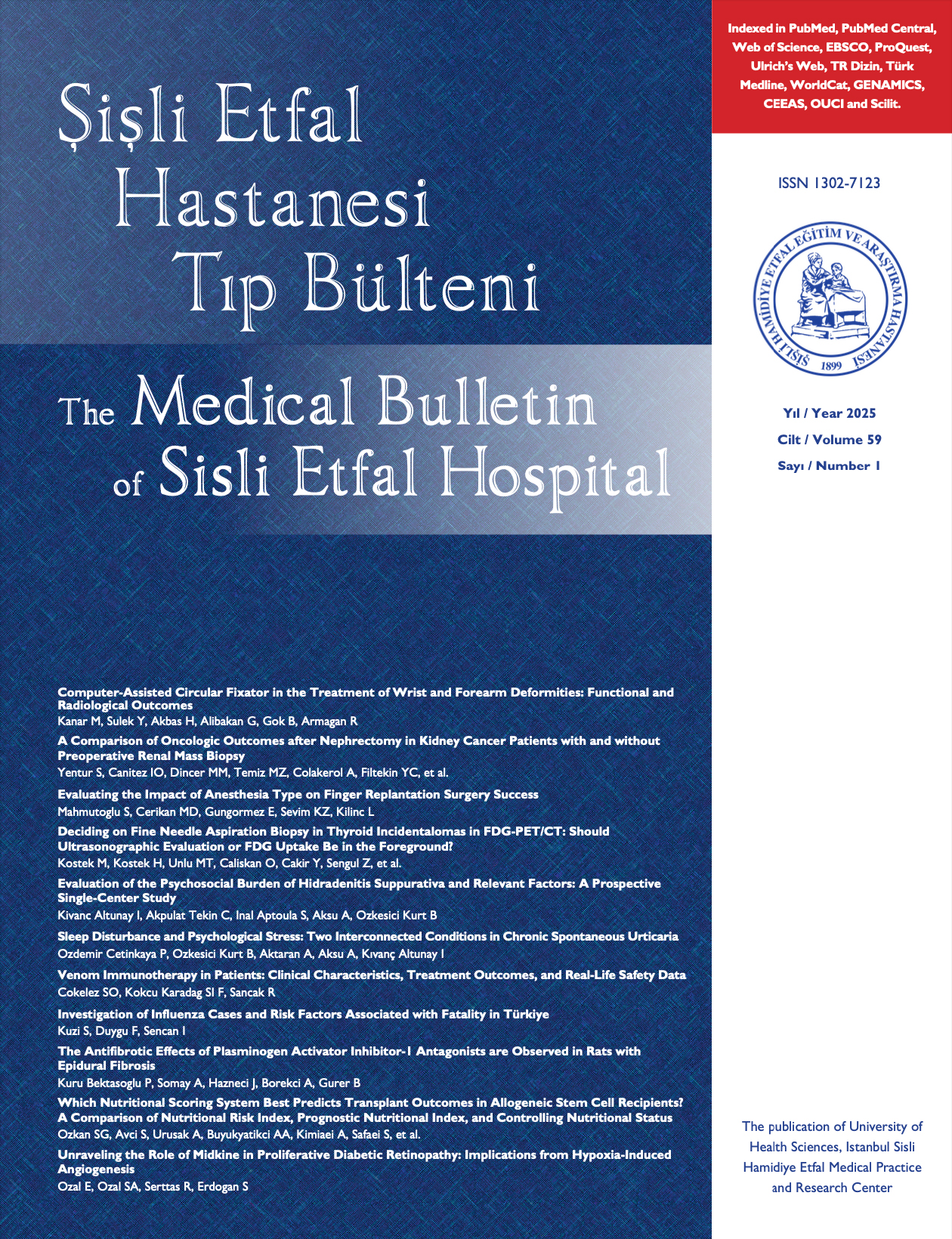
Comparison of Conventional Smear and Liquid-Based Cytology in Adequacy of Thyroid Fine-Needle Aspiration Biopsies without an Accompanying Cytopathologist
Ayse Ozdal Sayer1, Deniz Turkyılmaz Mut2, Bade Von Bodelschwingh2, Banu Yılmaz Ozguven3, Cennet Sahin21Department of Radiology, Bartin State Hospital, Bartin, Türkiye2Department of Radiology, University of Health Sciences Türkiye, Sisli Hamidiye Etfal Training and Research Hospital, Istanbul, Türkiye
3Department of Pathology, University of Health Sciences Türkiye, Basaksehir Cam and Sakura City Hospital, Istanbul, Türkiye
Objectives: In this study, we aimed to compare the adequacy of conventional smear (CS) and liquid-based cytology (LBC) methods in thyroid fine-needle aspiration biopsy (FNAB) samples obtained without an accompanying cytopathologist during the procedure. Furthermore, we aimed to investigate the presence of a significant difference between the rates of nodules classified as Bethesda Category III and malignancy in both techniques and the features of the nodules affecting malignancy.
Methods: A total of 625 nodules from 572 patients who were found suitable for biopsy were included in this retrospective study. FNABs were performed by interventional radiologists without an accompanying cytopathologist during the procedures. The specimens were either prepared using CS or LBC preparation methods. Cytopathological diagnostic adequacy and cytopathological results of the specimens were evaluated according to Bethesda category, and the relationship between the morphological findings was evaluated retrospectively.
Results: Of all the biopsy preparations, 338 (54.1%) of them were transferred to pathology in liquid-based solution and 287 (45.9%) were transferred as CS. Malignancy rates of the biopsy samples were found similar in both LBC and CS methods. Considering the nodules classified as Bethesda Category II, III, IV, V, and VI, there was no statistical difference between the results of both methods. Non-diagnostic biopsy rate was higher in the specimens prepared by CS method (p<0.001).
Conclusion: In this study, the adequacy rate of FNAB was found significantly higher in LBC method compared to the CS method. LBC was more practical and faster than the CS method. We think that LBC method may be preferred in FNAB of thyroid nodules.
Eşlik eden bir sitopatolog olmadan tiroid ince iğne aspirasyon biyopsilerinin yeterliliğinde konvansiyonel yayma ve sıvı bazlı sitolojinin karşılaştırılması
Ayse Ozdal Sayer1, Deniz Turkyılmaz Mut2, Bade Von Bodelschwingh2, Banu Yılmaz Ozguven3, Cennet Sahin21Bartın Devlet Hastanesi, Radyoloji Bölümü, Bartın2Sağlık Bilimleri Üniversitesi Şişli Hamidiye Etfal Eğitim ve Araştırma Hastanesi Radyoloji Anabilim Dalı, İstanbul
3Sağlık Bilimleri Üniversitesi, Başakşehir Çam ve Sakura Şehir Hastanesi, Patoloji Anabilim Dalı, İstanbul
AMAÇ: Bu çalışmada, işlem sırasında eşlik eden bir sitopatolog olmadan alınan tiroid ince iğne aspirasyon biyopsisi (İİAB) örneklerinde konvansiyonel yayma ve sıvı bazlı sitoloji (SBS) yöntemlerinin yeterliliğini karşılaştırmayı amaçladık. Ayrıca her iki teknikle elde edilen örneklerin Bethesda kategorisine göre sonuçları arasında anlamlı fark olup olmadığınının araştırılmasını amaçladık.
YÖNTEMLER: Biyopsi için uygun bulunan 572 hastadan toplam 625 nodül bu retrospektif çalışmaya dahil edildi. İİAB'ler işlemler sırasında eşlik eden bir sitopatolog olmadan girişimsel radyologlar tarafından gerçekleştirildi. Numuneler ya konvansiyonel yayma ya da SBS hazırlama yöntemleri kullanılarak hazırlandı. Örneklerin sitopatolojik tanı yeterliliği ve sitopatolojik sonuçları Bethesda kategorisine göre değerlendirildi ve morfolojik bulgular arasındaki ilişki retrospektif olarak değerlendirildi.
BULGULAR: Tüm biyopsi örneklerinden 338'i (%54,1) SBS yayma yöntemi kullanılarak, 287'si (%45,9) konvansiyonel smear olarak hazırlandı. Biyopsi örneklerinin malignite oranları hem SBS hem de konvansiyonel yayma yöntemlerinde benzer bulundu. Bethesda Kategori II, III, IV, V, VI olarak sınıflandırılan nodüller göz önüne alındığında, her iki yöntemin sonuçları arasında istatistiksel bir fark yoktu. Konvansiyonel yayma yöntemi ile hazırlanan örneklerde nondiagnostik biyopsi oranı daha yüksekti (p<0,001).
SONUÇ: Bu çalışmada SBS yönteminde İİAB yeterlilik oranı konvansiyonel smear yöntemine göre anlamlı derecede yüksek bulundu. SBS, konvansiyonel yayma yönteminden daha pratik ve hızlıydı. Tiroid nodüllerinin İİAB'sinde SBS yönteminin tercih edilebileceğini düşünüyoruz. (SETB-2021-11-335)
Manuscript Language: English



















